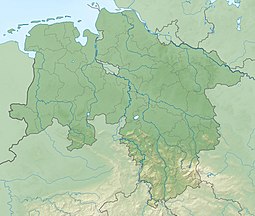| This article needs additional citations for verification. Please help improve this article by adding citations to reliable sources. Unsourced material may be challenged and removed. Find sources: "Steinhuder Meer" – news · newspapers · books · scholar · JSTOR (January 2024) (Learn how and when to remove this message) |
| Steinhuder Meer | |
|---|---|
 Wilhelmstein fortress in the lake Wilhelmstein fortress in the lake | |
 | |
| Location | 30 km NW of Hanover, Lower Saxony |
| Coordinates | 52°28′N 9°20′E / 52.467°N 9.333°E / 52.467; 9.333 |
| Primary inflows | Groundwater, precipitation |
| Primary outflows | Steinhuder Meerbach (towards Weser) |
| Basin countries | Germany |
| Max. length | 8 km (5 mi) |
| Max. width | 4.5 km (2.8 mi) |
| Surface area | 29.12 km (11.24 sq mi) |
| Average depth | 1.35 m (4 ft 5 in) |
| Max. depth | 3 m (9.8 ft) |
| Water volume | 0.088 km (0.021 cu mi) |
| Surface elevation | 38 m (125 ft) |
| Islands | 2 (Wilhelmstein and Badeinsel) |
| Settlements | Steinhude, Hagenburg, Mardorf |
| Ramsar Wetland | |
| Designated | 26 February 1976 |
| Reference no. | 87 |
Lake Steinhude, German: Steinhuder Meer, German pronunciation, is a lake in Lower Saxony, Germany located 30 kilometres (19 mi) northwest of Hanover. Named after the nearby village of Steinhude, it has an area of about 30 square kilometres (12 sq mi), making it the largest lake of northwestern Germany. At the same time, Lake Steinhude is very shallow, with an average depth of only 1.35 metres (4.4 ft) and a maximum depth of less than 3 metres (9.8 ft). It lies within a region known as the Hanoverian Moor Geest.
Geology
It is part of the glacial landscape formed after the recession of the glaciers of the latest Ice Age, the Weichselian glaciation. There are two theories regarding how the lake of Steinhude was formed. One of them says that glaciers gouged out the hole and meltwater filled it. The other theory states that an ice storm formed the hole and as the groundwater rose, the lake was created. In its middle there is a small artificial island carrying an 18th-century fortification, the Wilhelmstein. Today the lake is the heart of a nature reserve, the Steinhuder Meer Nature Park, and is also used as a recreational area.
Islands
The lake has two islands, both of them artificial:
- Wilhelmstein (1.25 hectares or 3.1 acres) off Hagenburg was built between 1761 and 1765. It was turned into a military fortress between 1765 and 1767 by William, Count of Schaumburg-Lippe. Afterwards it briefly served as military school (one of its graduates was Gerhard von Scharnhorst who later became Chief of the Prussian General Staff). From 1777 until 1867 the island was used as state prison of the Principality of Schaumburg-Lippe.
- Badeinsel Steinhude (3.5 hectares or 8.6 acres) was built in 1974–75 using sand retrieved from the lake. It has a sandy beach which is popular during summer. Access to the island is via an 80-metre (260 ft) pedestrian bridge from Steinhude.

Tourism
The lake is a popular destination for locals and for vacationists. Up to three ships offer cruises; they are supplemented by smaller boats running on schedule across the lake. A bike path approximately 35 kilometres (22 mi) long encircles the lake, crossing various landscapes.
References
- "Steinhuder Meer". Ramsar Sites Information Service. Retrieved 25 April 2018.
- "Lake Steinhude". www.germany-tourism.co.uk. Archived from the original on 27 September 2011. Retrieved 21 March 2011.
- "Wie das Steinhuder Meer entstand" (in German). Archived from the original on 19 July 2011. Retrieved 8 May 2008.
External links
- Steinhuder Meer Nature Park Archived 11 July 2017 at the Wayback Machine
- Nixdorf, B.; et al. (2004), "Steinhuder Meer", Dokumentation von Zustand und Entwicklung der wichtigsten Seen Deutschlands (in German), Berlin: Umweltbundesamt, p. 25